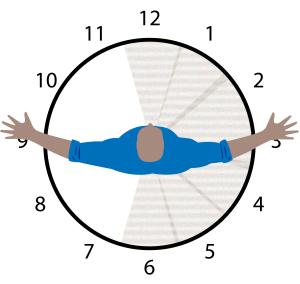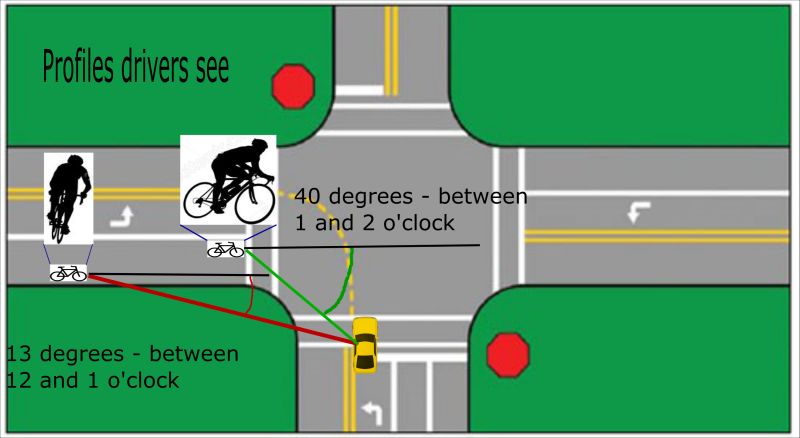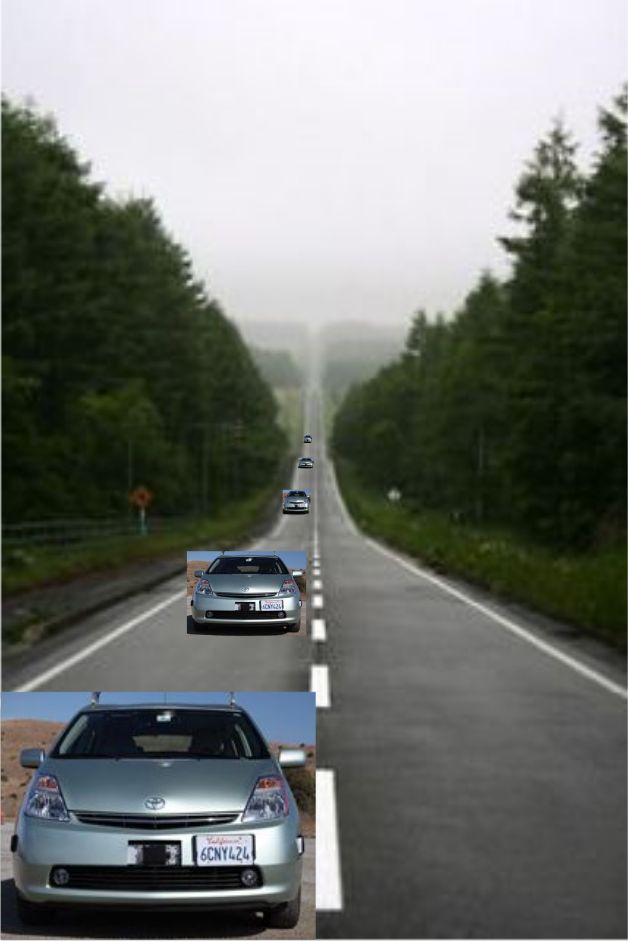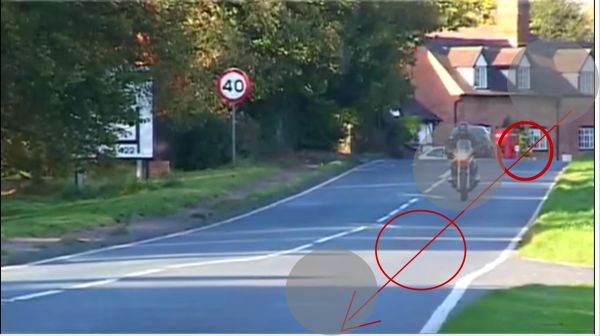This post explains imperfections of human perception in terms of cyclist traffic safety. For explanation of difference between being seen and being noticed, read this post: Bicycle lights – Difference between “seeing” and “noticing”.
A large percentage of cyclists have experienced situations where drivers didn’t see them – resulting in shock and hard braking, or an actual accident. Are drivers so rude, inconsiderate, do they look at all? There sure are such drivers, but most are normal, everyday people, paying attention when driving. In order to avoid such situations, a few things need to be understood first, they will be explained in this post.
The same situation happens behind a wheel of a car. Approaching an intersection, checking left and right, pulling in, when all of a sudden a bike appears. The first thought is that the cyclist must have been going too fast! Then, a man/woman can ask themselves – “I still checked left and right – am I blind?!”
The answer is, unfortunately: yes… in a way. For very short periods of time, the human eye sees nothing at all. This is usually not a problem in everyday life. However, in traffic situations, when this temporary “blindness” means not noticing an oncoming vehicle, this can be a big problem.
If human eye limitations are understood and techniques to overcome them are applied, this problem can be solved.
Table Of Contents (T.O.C.):
- How human eye works and it’s limitations
1.1. Peripheral sight limitations
1.2. Noticing only lateral movement
1.3. Cut out scenery, brain filling in the blanks
1.4. Blindness by the Sun - How to remain safe, seen and noticed
- Video about cycling in traffic – safely
1. How human eye works and it’s limitations
1.1. Peripheral sight limitations
Human sight is clear only in a narrow, about 20-degree cone. Anything wider is in blurry peripheral vision. Peripheral vision is good at detecting (lateral) movement but bad at detecting details. If you don’t believe it, try standing 5 steps away from a parked car, look at one light (corner of the car) and, without moving eyes (or head), try reading the license plate. Is it blurry?

Picture 1
Peripheral vision, although blurry for details, is very good at spotting movement. Any movement is easily picked by peripheral vision, enabling us to focus on it once spotted.
When approaching an intersection, a driver will look left and right. Since the bicycle’s profile is very narrow, it will remain in the central, clear, field of vision for a very short time. Most of the time, they will remain in (blurry) peripheral vision. Peripheral vision is good at detecting lateral movement, but if there’s no lateral movement, there’s a high chance that the cyclist will remain unseen.
How to tell you’re in a situation like this? If you see a vehicle pulling in from a side road by looking almost directly in front of you, then the driver also sees your front profile – narrow and small. If you see a vehicle at, for example, a 60-degree angle to the right (at about 2 o’clock), then they also see you at the same angle, seeing your wider profile.

For example: all the way to the left is “at 9 o’clock”. Directly behind is “at 6 o’clock”. Straight ahead is “at 12 o’clock”.
At the cost of stating the obvious: the angles are measured relative to the direction of movement, the direction objects see each other at. Simply moving one’s head to a side doesn’t change the view, or approaching angle.
Picture 2
Solution? If in a situation like this, a vehicle on the side of the road being almost directly in front of you, start moving from one part of your lane to the other (checking for traffic coming behind before moving, the manoeuvre must be safe). That way you will change the angle, showing the driver your broader, side profile, not the front one.

Picture 3
1.2. Noticing only lateral movement
Everything further than one meter, human eyes see only in two dimensions. This means that movement directly towards us (or directly away from us), we can register only if there’s some lateral movement/shape change as well. Movement of a car coming towards us from a distance we can only register by noticing stationary objects it moves past, or by spotting the growing distance between headlights, that is the car becoming wider as it approaches – practically “lateral movement”.

Picture 4
Picture 4 shows a car, appearing larger as it approaches. However, only in the last 30 meters, a size change is big and apparent. When in the distance, there’s almost no change in size even between two 100 meter distant shots.
The problem with bicycles is they are rather narrow from the front. Noticing they are moving, not just some stationary, unimportant object, is possible only when they are too close. Once they are close, at some 10 meters, they start rapidly growing in size (from the driver’s point of view), causing them to panic, often slamming the brakes, or swerving, because something just “jumped” at them out of nowhere.
That is why, the only way for a cyclist to be noticed, is if there is some lateral movement relative to the driver’s point of view. What happens at intersections?

The angle at which cyclist and driver see each other
Picture 5
If driver and cyclist are approaching an intersection at such speeds that the angle at which they see each other remains the same (parallel lines in picture 5), then from the driver’s point of view there is no lateral movement of the cyclist – they will hardly be noticed.
How to tell if you are in this situation? If a car doesn’t move in our sight (in picture 5 it is always at about 2 o’clock from the cyclist’s point of view), then we are not moving laterally in their sight either.
Solution? If there’s no lateral movement, the only way to “achieve” it is to change speed (and with it the viewing angle) – on a bicycle best by slowing down. Also, swerving within one’s lane is a good thing, as long as there’s no traffic overtaking, coming from behind. This also enables the cyclist to be spotted more easily with the driver’s peripheral vision. If zig-zag swerving isn’t safe in a given situation, a simple movement from one part of the lane to the other (right to left, or vice-versa) can be enough to “wave a red flag” to a driver’s peripheral vision – “something’s moving here!”
1.3. Cut out scenery, brain filling in the blanks
Now comes the most interesting phenomena. When moving our head from left to right in order to scan the scene, our eyes are incapable of doing so fluidly. Unless tracking a particular laterally moving object, our eyes will take a few “snapshots” of the scenery, filling the blanks with what is expected!

Picture 6
Everything outside 3 red circles in picture 6, unless there’s vast lateral movement, will be painted according to what the brain expects – grey clear road with buildings in the background.
If you don’t believe this, stand in front of a mirror. Look into your left, then into your right eye. Can you notice any eye movement in your reflection? Someone looking from aside will easily see your eyes moving, but you will not be able to register any movement in your reflection.
The faster you move your head from side to side, the larger the unseen gaps become! Why is this important? Imagine a driver at an intersection, quickly looking from right to left, like in the picture 7:

The eyes catch a few details, leaving the rest blurry.
Picture 7
In the picture 7, the motorcyclist is most likely to remain unseen.
How to avoid this?
For a driver: it is best to pick three reference points to focus on when looking both left and right. One close, at about 10 meters, other at about 30, the third over 50 meters. With some practice, this takes just a split second longer, and it helps a lot to spot all the oncoming vehicles – whether large or small. Make a point of looking next to the windscreen pillars, in case there’s a bicycle “hiding” behind them. Look twice left and right – that literally doubles the chance of seeing everything. Always start slowing down when approaching an intersection (change of speed often = change of viewing angle, which enables lateral movement and use of peripheral vision for spotting dangers).
For a cyclist: Change of speed (slight slowing down) with zig-zag movement within the lane if it is safe (no cars coming from behind). Because of a bicycle’s narrow profile, by moving left-right within their lane, cyclists also increase the chance of not being hidden from the driver’s sight by windscreen pillars, or a land post on the side of the road, as well as grabbing the attention of drivers’ peripheral vision.
1.4. Blindness by the Sun
When the sun is low, whether at sunrise, or sunset, contrast is lost and objects falling into the shadow of “up sun” objects are especially difficult to see.


Moped coming from the sun (left), in the shadow of a building, is almost invisible. Lights are the only things that are more or less visible.
Picture 8
Solution? Lights. Not just during the dark. If riding (or driving) during sunrise, or sunset, it is wise to have the lights on, both front and rear.
2. How to remain safe, seen and noticed
- Proper bicycle lights when the visibility is low, or the sun is low.
- Bright (reflective) clothing. Reflective ankle bands (Amazon affiliate link) or pedal mounted reflectors will move up-down, catching the driver’s attention.
- Use bicycles relative slowness to one’s advantage. There’s enough time to look through the windshields of approaching cars. Look into the eyes of the drivers. Do they see you? Are they looking at you?
- Have a prepared manoeuvre in case the worst possible situation happens. Driver doesn’t give way. Or starts turning towards you. Whether it is braking, or turning, or both – always have a backup plan. Expect and be prepared for the worst, stupidest possible driver’s reactions.
Post that explains how to improve cyclist’s visibility and safety with proper lane positioning:
Bicycle lane positioning and riding in traffic
3. Video about cycling in traffic – safely
Traffic safety article series:
- Sorry, I didn’t see you – cyclist traffic safety
how the human eye works and how to get drivers’ attention - Bicycle lane positioning and riding in traffic
how to avoid drivers’ “blind spots” - Bicycle lights, and the difference between “visible” and “noticeable”
why they are important, and how to properly “light” a bicycle - Typical risky situations when cycling in traffic
9 scenarios you should be prepared for in advance


Totally agree regarding being seen!
Aside from lights, I like to use bright fluoro clothing, particularly on the legs. That way the bright clothing is moving and easier for drivers to notice.
Yes, reflective ankle straps or pedal mounted reflectors will move up-down and catch the driver’s attention more easily.
A reflective vest might not be covered by the car’s low-beam lights, but pedals and legs often will.
my experience over the years whether i have been riding a motorcycle or a bicycle is most car drivers do see you but they will allways cut you off or push you off the road so now all my riding is done on bicycle paths.road riding is just too risky,another danger of road riding is gear often falls of work utes or tires blow out and fly your way,i have even seen spare tires rolling down a road,i have lost a few buddies due to road riding so i am very wary about that one.